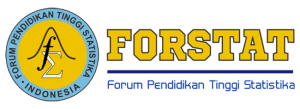Konsumsi Rokok Masyarakat Kota Bandung Tahun 2015 dengan Model Hurdle Negatif Binomial (Hurdle-Nb)
DOI:
https://doi.org/10.34123/jurnalasks.v9i2.142Abstract
Lifestyle that high risk to health is smoking behavior. Smoking behavior has a negative impact on health, both for active smokers and passive smokers. In addition there are also negative impacts in terms of economy. In Bandung, spending on cigarettes ranks second after the food commodity. The number of cigarettes smoked each day is influenced by demographic variables, social environment variables, political variables, and cultural variables. In this study, the Bandung cigarette consumption and the factors suspected to affect, ie sex, age, work status, and education, will be modeled by Hurdle-NB regression. The results showed that Log model, age variable, work status, and education influence to the average of cigarette consumption. While on Logit model, gender variable, age, work status, and education have an effect on the tendency of someone to smoke or not.
Downloads
References
Ambarwati, dkk. 2014. Media Leaflet,Video, dan Pengetahuan Siswa SD Tentang Bahaya Merokok (Studi pada Siswa SDN 78 Sabrang Lor Mojosongo Surakarta). Jurnal Kesehatan Masyarakat 10 (1): 7 – 13.
Santi. 2013. Hubungan Pengetahuan Tentang Rokok dengan Sikap terhadap Bahaya Merokok pada Siswa SMK 1 Batik Surakarta. Fakultas Kedokteran Universitas Muhammadiyah Surakarta. Skripsi. Surakarta.
Moghimbeigi, A, dkk. (2009). A Score Test for Zero-Inflation in Multilevel Count Data. Computational Statistics and Data Analysis, 53: 1239 – 1248.
Wijayanti, Erlina,dkk. 2017. Faktor-faktor yang Berhubungan dengan Perilaku Merokok pada Remaja Kampung Bojong Rawalele, Jatimakmur, Bekasi. Global Medical and Health Communication: 5(3): 194 – 8.
Cameron, A.Colin, & Trivedi, Pravin K. 1998. Regression Analysis of Count Data. New York: Cambridge University Press.
Bain, L.J. dan Engelhardt, M. (1992). Introduction to Probability and Mathematical Statistiks Second Edition. California: Duxbury Press
Cantoni, E., and A. Zedini. 2010. A Robust Version of the Hurdle Model.Journal of Statistical Planning and Inference, Vol.141(3), pp:1214-1223.
Gujarati, Damodar. 2004. Basic Econometrics, Fourth Edition. The McGraw-Hill Companies.
Hestiana, Fida. 2013. Pemodelan Mixture Count Regression Pada Data Zero Inflated dengan Pendekatan Bayesian (Studi Kasus: Jumlah Batang Rokok Yang Dihisap Setiap Hari di Provinsi Sumatera Selatan Tahun 2010). Jakarta: Sekolah Tinggi Ilmu Statistik.
Kristiono, Cahyo. 2010. Regresi ZINB untuk Pemodelan Data Respon Count dengan Excess Zeros (Studi Kasus: Konsumsi Miras pada Remaja). Bandung: Universitas Padjadjaran.
Kutner, M. H., Nachtsheim, C. J., Neter, J. dan Li, W., 2005. Applied Linear Regression Models, Fifth Edition. Mc Graw Hill Companies, Inc.
McCullagh, P. dan Nelder, J.A. (1989).Generalized Linear Models, 2nd Ed. New York: Chapman and Hall
Pontoh, Septiani R dan Faidah, Defi Y. 2015. Penerapan Hurdle Negative Binomial pada Data Tersensor. Yogyakarta: UNY.
Smet, Bart, dkk. 1999. Determinants of Smoking Behaviour Among Adolescent in Semarang, Indonesia. Tabacco Control; 8: 186 – 191.
Widayanti, Citra Yanuar. 2017. Pemodelan Banyak Kematian Bayi dan Ibu di Provinsi Jawa Barat Menggunakan Regresi Binomial Negatif Bivariat. Bandung: Tesis. Bandung: Universitas Padjadjaran.
Kementerian Kesehatan. 2010. Riset Kesehatan Dasar Riskesdas 2010. Jakarta: Badan Penelitian dan Pengembangan Kesehatan Kemsterian Kesehatan RI.
Kemeterian Kesehatan. 2017. Profil Kesehatan Indonesia Tahun 2016. Jakarta: Kemeterian Kesehatan RI.
https://sains.kompas.com/read/2018/01/05/070500823/kerugian-ekonomi-dari-konsumsi-rokok-indonesia-hampir-rp-600-triliun (Diakses 24 Oktober 2018)
http://theconversation.com/riset-terbaru-kerugian-ekonomi-di-balik-konsumsi-rokok-di-indonesia-hampir-rp600-triliun-89089 (Diakses 24 Oktober 2018)
https://www.merdeka.com/uang/penelitian-pengeluaran-masyarakat-indonesia-untuk-beli-rokok-terus-naik.html (Diakses 24 Oktober 2018)
















